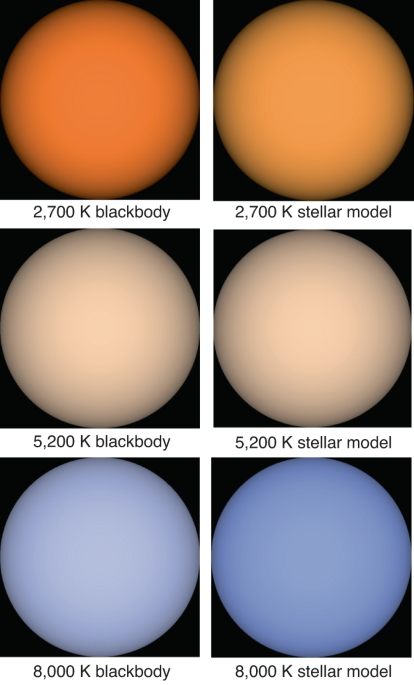Play all audios:
Access through your institution Buy or subscribe Harre and Heller take model stellar spectra from the PHOENIX spectral library for cooler stars (2,300–12,000 K) across a range of
metallicities, and from the TLUSTY repository for hotter stars (16,000–55,000 K), choosing only solar metallicity models. These spectra were then convolved with the colour response functions
of the red-, green- and blue-sensitive cone cells in the human eye. The presence of strong molecular absorption bands, particularly in the cooler stars, resulted in a substantial difference
between the derived spectrum and a blackbody at the same effective temperature (see image, where the stars have had a limb-darkening effect applied). The hotter stars also differ
substantially from a blackbody representation. White dwarf stars are well approximated by a blackbody and old, cold white dwarfs appear a pale orange colour. The researchers match the
convolved stellar spectra with spectral types and plot a main sequence across a standard colour wheel (see their Fig. 2). Late-type stars (M, K) inhabit the orange side of the red segment,
while early-type (O, B, A) stars are indeed blue. Intermediate temperature stars (G, F) cross the wheel through the central white portion (with the Sun a pale peach colour), meaning that the
yellow, green, cyan and magenta portions are not populated by main sequence stars at all. This is a preview of subscription content, access via your institution ACCESS OPTIONS Access
through your institution Access Nature and 54 other Nature Portfolio journals Get Nature+, our best-value online-access subscription $32.99 / 30 days cancel any time Learn more Subscribe to
this journal Receive 12 digital issues and online access to articles $119.00 per year only $9.92 per issue Learn more Buy this article * Purchase on SpringerLink * Instant access to full
article PDF Buy now Prices may be subject to local taxes which are calculated during checkout ADDITIONAL ACCESS OPTIONS: * Log in * Learn about institutional subscriptions * Read our FAQs *
Contact customer support AUTHOR INFORMATION AUTHORS AND AFFILIATIONS * Nature Astronomy https://www.nature.com/natureastronomy Paul Woods Authors * Paul Woods View author publications You
can also search for this author inPubMed Google Scholar CORRESPONDING AUTHOR Correspondence to Paul Woods. RIGHTS AND PERMISSIONS Reprints and permissions ABOUT THIS ARTICLE CITE THIS
ARTICLE Woods, P. Shifting colours. _Nat Astron_ 5, 229 (2021). https://doi.org/10.1038/s41550-021-01328-w Download citation * Published: 16 March 2021 * Issue Date: March 2021 * DOI:
https://doi.org/10.1038/s41550-021-01328-w SHARE THIS ARTICLE Anyone you share the following link with will be able to read this content: Get shareable link Sorry, a shareable link is not
currently available for this article. Copy to clipboard Provided by the Springer Nature SharedIt content-sharing initiative

